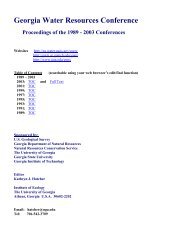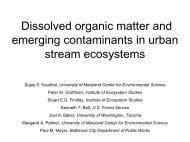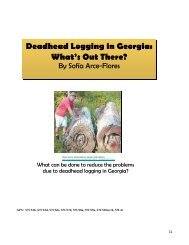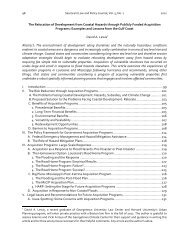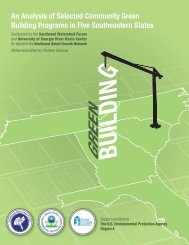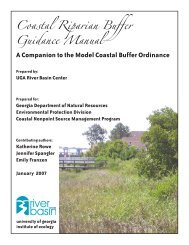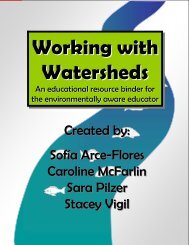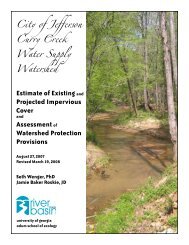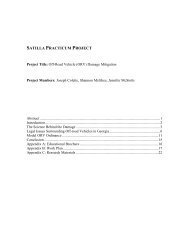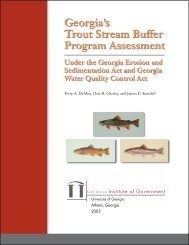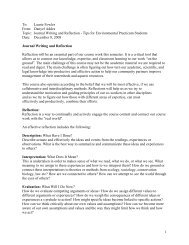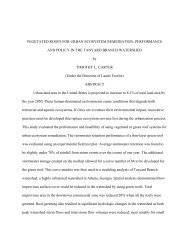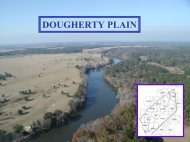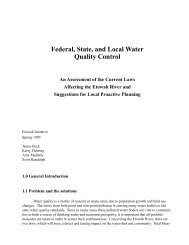1 Bibliographic Review of Sources Relevant to Development of Draft ...
1 Bibliographic Review of Sources Relevant to Development of Draft ...
1 Bibliographic Review of Sources Relevant to Development of Draft ...
Create successful ePaper yourself
Turn your PDF publications into a flip-book with our unique Google optimized e-Paper software.
Savannah River Annotated Bibliography: January 2003<br />
We present a conceptual model for identifying res<strong>to</strong>ration sites for riparian wetlands and discuss<br />
its application <strong>to</strong> reaches within the Upper Arkansas River basin in Colorado. The model utilizes a<br />
Geographic Information System (GIS) <strong>to</strong> analyze a variety <strong>of</strong> spatial data useful in characterizing<br />
geomorphology, hydrology, and vegetation <strong>of</strong> riparian wetland sites. The model focuses on three<br />
basic properties <strong>of</strong> riparian wetland sites: relative soil moisture, disturbance regime, and<br />
vegetative characteristics. Res<strong>to</strong>ration potential is evaluated as a combination <strong>of</strong> nominal scores<br />
from wetness, land cover, and disturbance indices. Application <strong>of</strong> these methods <strong>to</strong> field sites<br />
within the Upper Arkansas River basin identifies a wide range <strong>of</strong> riparian wetland sites for<br />
preservation or res<strong>to</strong>ration. Potential sites within identified reaches are prioritized using size and<br />
proximity criteria.<br />
Rheinhardt, R. D., M. M. Brinson and P. M. Farley (1997). "Applying wetland reference<br />
data <strong>to</strong> functional assessment, mitigation, and res<strong>to</strong>ration." Wetlands 17(2): 195-<br />
215.<br />
This study demonstrates the hydrogeomorphic (HGM) assessment procedure by identifying<br />
ecological functions performed by mineral soil wet flats, obtaining quantitative field data from 19<br />
wet Bats (reference sites) in southeastern North Carolina, and modeling wetland functions using<br />
variables derived from those field data. We chose a subset <strong>of</strong> the 19 reference sites <strong>to</strong> demonstrate<br />
how HGM assessment can be used <strong>to</strong> measure ecosystem functions before and after a project site<br />
is altered and the degree <strong>to</strong> which ecosystem res<strong>to</strong>ration can compensate for a reduction in<br />
functions caused by a project's impact. HGM assessment can be used <strong>to</strong> determine the minimum<br />
area over which res<strong>to</strong>ration should be applied <strong>to</strong> achieve a no-net-loss in function objective. The<br />
ratio <strong>of</strong> wetland area res<strong>to</strong>red <strong>to</strong> wetland area altered by a project impact (compensa<strong>to</strong>ry mitigation<br />
ratio) varies among functions and is influenced by (1) the magnitude <strong>to</strong> which any given function<br />
occurs at a project site both before and after the site is altered, (2) the magnitude <strong>to</strong> which any<br />
given function occurs at a compensa<strong>to</strong>ry mitigation site both before and after res<strong>to</strong>ration is<br />
applied, and (3) the rate at which any given function is res<strong>to</strong>red.<br />
Schmidt, J. C., R. H. Webb, R. A. Valdez, G. R. Marzolf and L. E. Stevens (1998).<br />
"Science and values in river res<strong>to</strong>ration in the Grand Canyon - There is no<br />
res<strong>to</strong>ration or rehabilitation strategy that will improve the status <strong>of</strong> every riverine<br />
resource." Bioscience 48(9): 735-747.<br />
Forest dynamics and productivity<br />
Allen, B. and R. Sharitz (1999). Post-hurricane vegetation dynamics in old-growth forests<br />
<strong>of</strong> Congaree Swamp National Monument. On the Frontiers <strong>of</strong> Conservation: 10th<br />
Conference on Research and Resource Management in Parks and on Public<br />
Lands, Asheville, NC, The George Wright Society, Inc.<br />
Bates, R. and J. Williams (1986). Estimation <strong>of</strong> biomass and primary productivity <strong>of</strong> an<br />
early successional forest site on the Santee River floodplain. Freshwater Wetlands<br />
and Wildlife Symposium, Charles<strong>to</strong>n, SC.<br />
Conner, W. (1995). "Woody plant regeneration in three South Carolina Taxodium/Nyssa<br />
stands following Hurricane Hugo." Ecological Engineering 4: 277-287.<br />
Hesse, I., W. Conner and J. Day Jr. (1996). Herbivory impacts on the regeneration <strong>of</strong><br />
forested wetlands in Louisiana. Proceedings <strong>of</strong> the Southern Forested Wetlands<br />
Ecology and Management Conference, Clemson University, Clemson, SC,<br />
26



